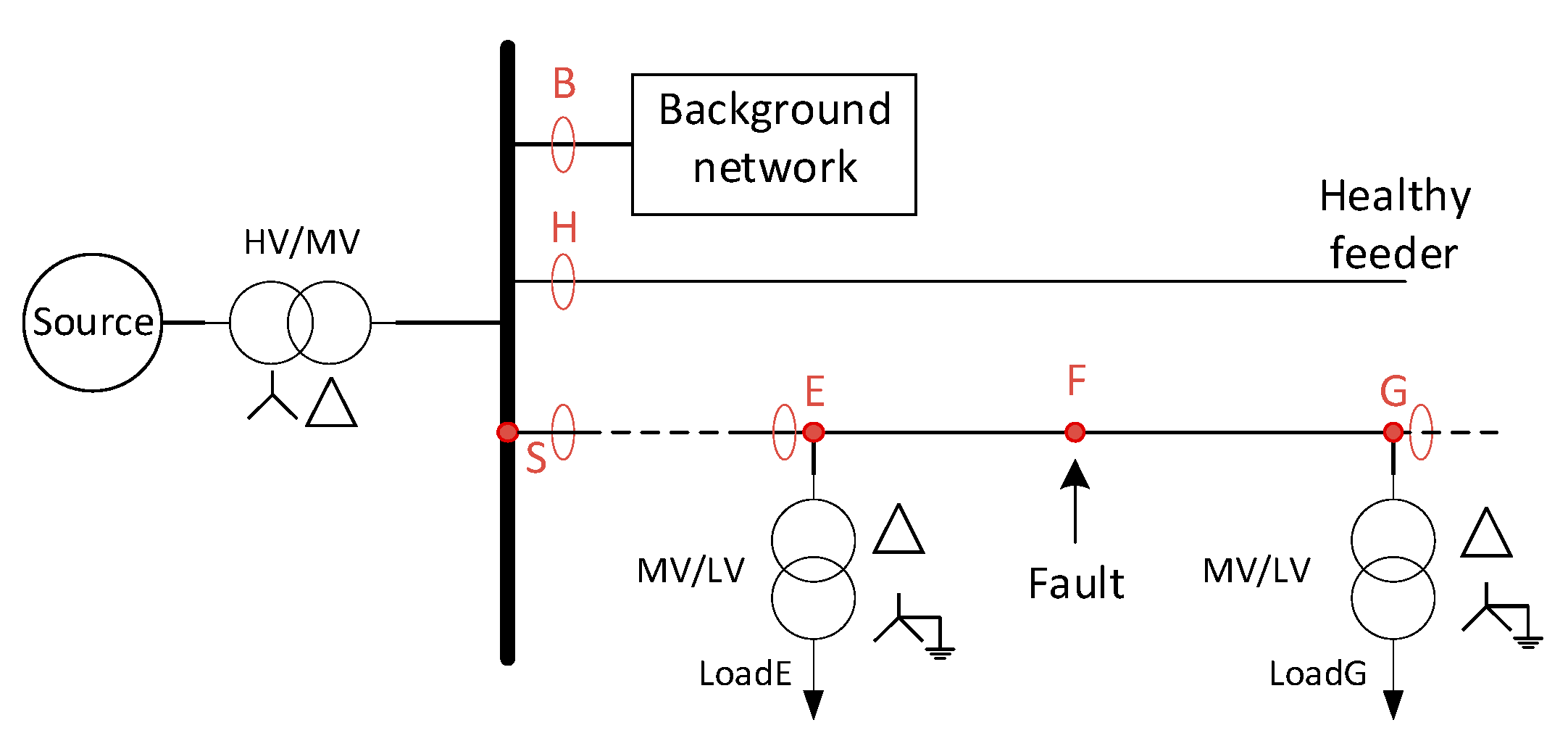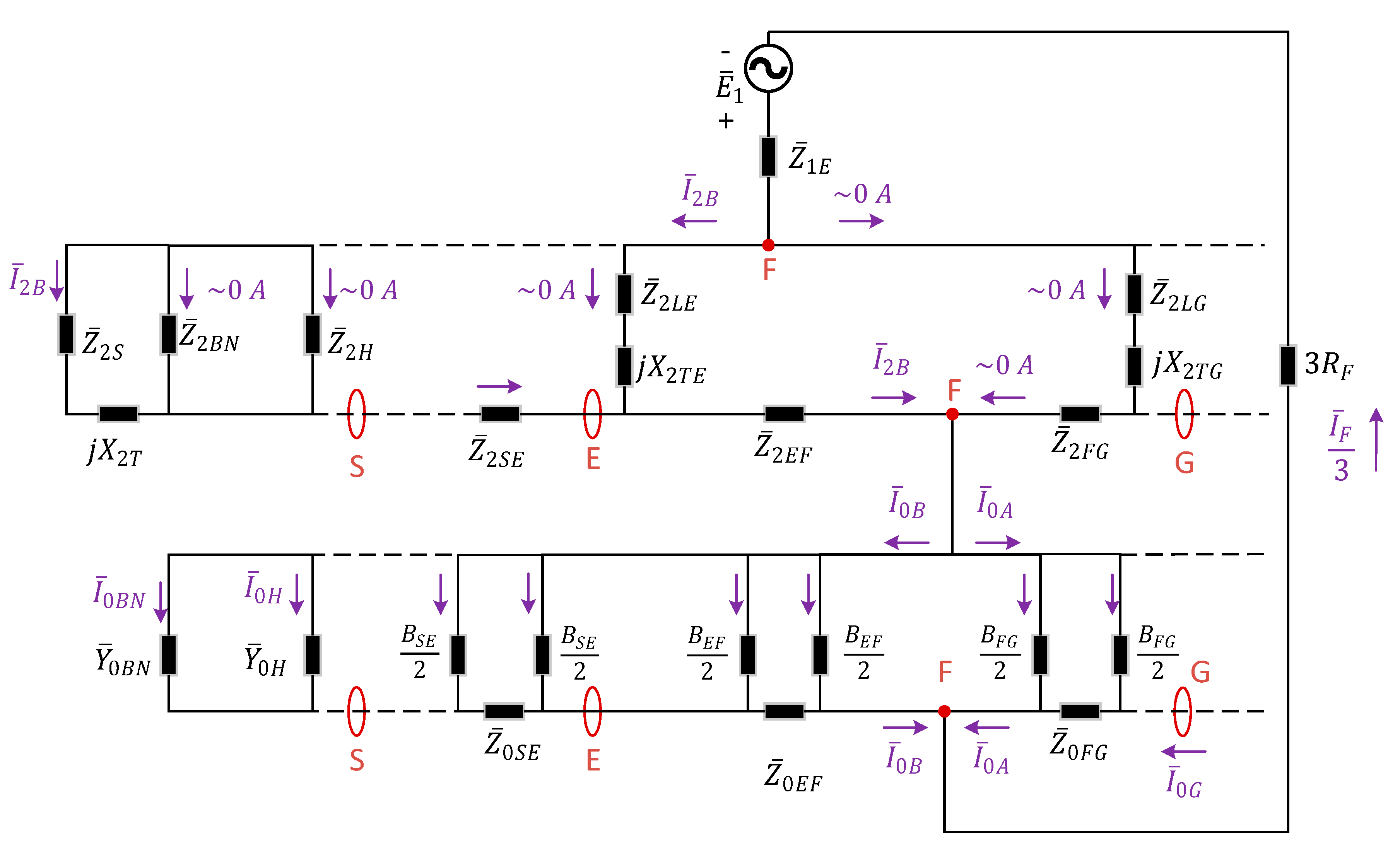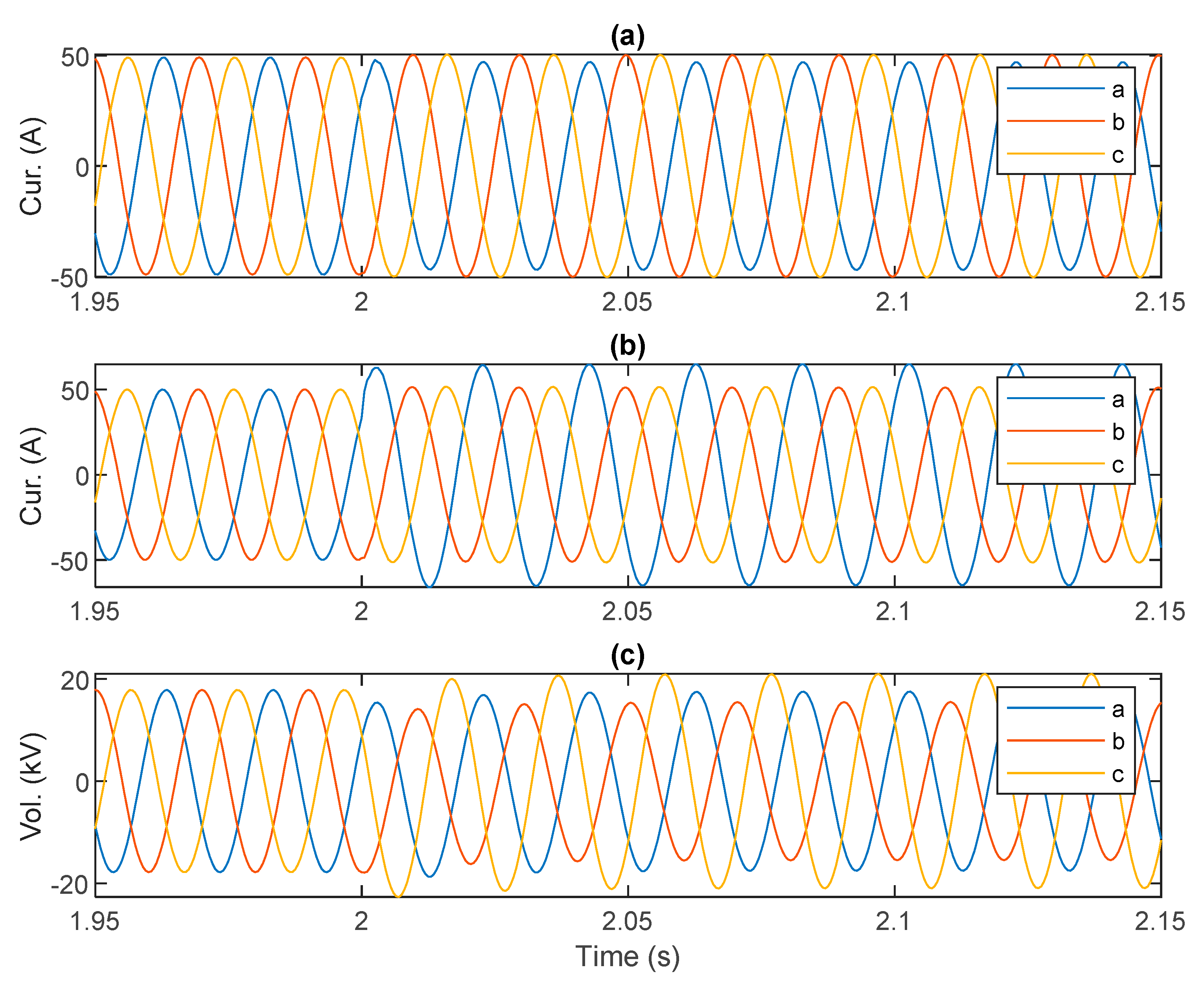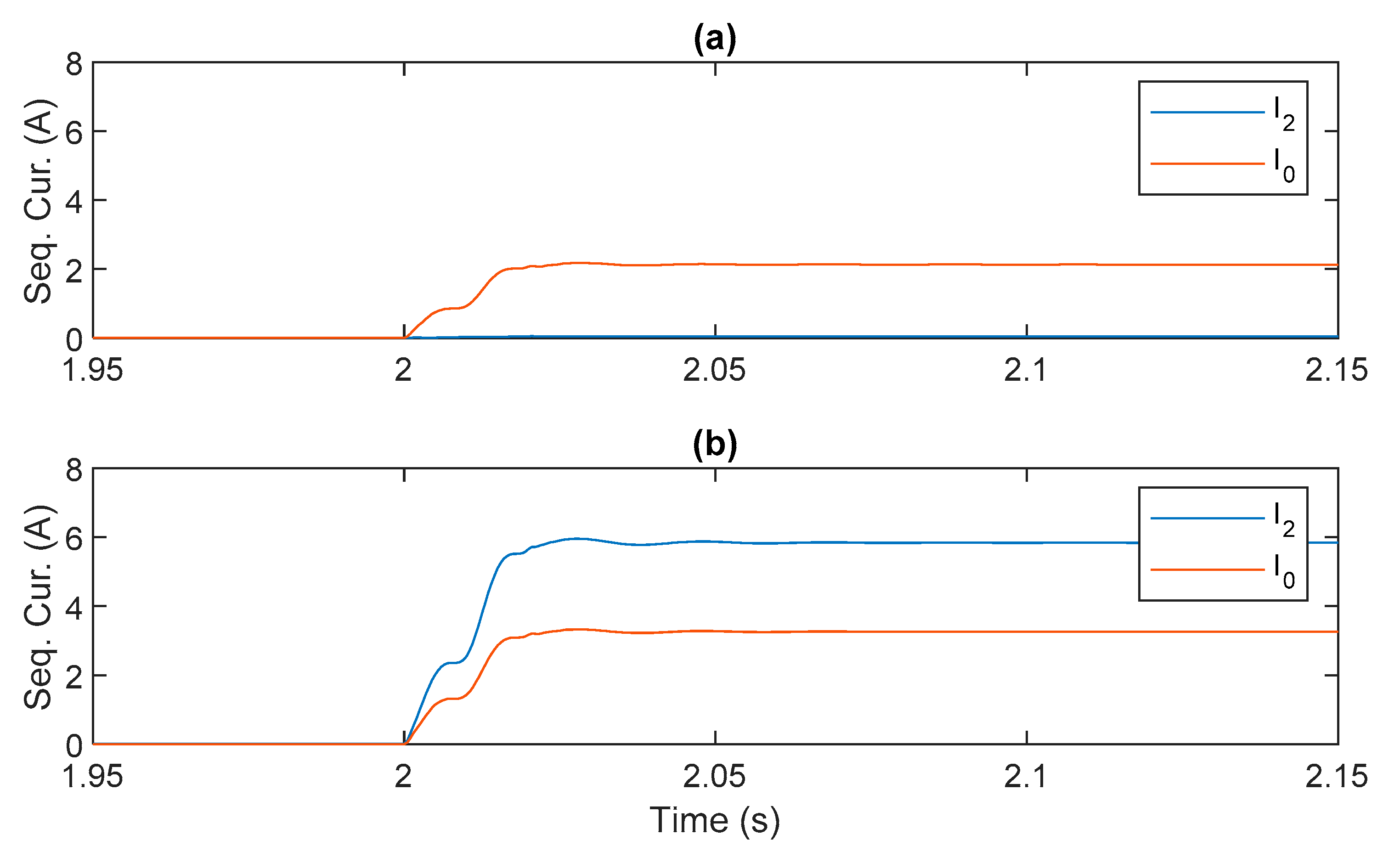Non-Directional Earth Fault Passage Indication in Isolated Neutral Distribution Networks
Abstract
1. Introduction
- (1)
- Feeder identification: Only the faulty feeder is identified. This is usually an integral part of the feeder relay protection.
- (2)
- Fault Passage Indication (FPI): The faulted segment, e.g., lines or cables linking two secondary substations on the feeder, is identified. The purpose of FPI is to indicate whether the fault current has passed through the measurement point at which the FPI device is installed. By installing multiple FPI devices at various points (typically secondary substations) in the network, the faulted segment can be identified and visualized for the operator at the control center.
- (3)
- Distance estimation: The accurate fault location i.e., its distance from the beginning of the faulted feeder is estimated.
2. Proposed Methods
2.1. Theory
2.2. Method I
- (1)
- The faulted feeder is indicated first by the operation of the feeder protection relay.
- (2)
- The zero sequence current for each measurement point (ideally at every secondary substation) on the faulted feeder is calculated and sent to a control center where all calculated zero sequence currents are collected.
- (3)
- For each measuring point, these values are scaled so that they are divided by the one from the beginning of the feeder. If the scaled value is greater than 1, it is concluded that the measuring point in question is on the fault passage. Otherwise, it is off the fault passage.
- (4)
- The faulty segment is determined as the segment linking the last secondary substation on the fault passage and the first secondary substation off the fault passage.
2.3. Method II
- (1)
- The procedure at each measuring point is triggered once the magnitude of the zero sequence current exceeds a pre-set threshold.
- (2)
- The magnitude of the negative sequence current is calculated (ideally at every secondary substation).
- (3)
- If the calculated value exceeds a low pre-set threshold, a fault indication signal is issued to the control room.
- (4)
- The faulty segment is determined as the segment linking the last measurement point from which the fault indication signal is received and the first measurement point that sends no signal.
3. Simulation Results
4. Discussion
4.1. Limitations of the Proposed Methods
4.2. Effect of Unbalanced Load
5. Conclusions
Author Contributions
Funding
Conflicts of Interest
Abbreviations
| Equivalent impedance of the positive sequence circuit of the network | |
| Negative sequence source impedance | |
| Negative sequence reactance of the main transformer | |
| Equivalent negative sequence impedance of the background network | |
| Equivalent negative sequence impedance of the healthy feeder | |
| Negative sequence impedance of the faulted feeder between S and E | |
| Negative sequence impedance of load E | |
| Negative sequence reactance of transformer E | |
| Negative sequence impedance of the feeder between E and the fault location | |
| Negative sequence impedance of the feeder between the fault location and G | |
| Negative sequence impedance of load G | |
| Negative sequence reactance of transformer G | |
| Zero sequence admittance of phase to earth capacitances of the background network | |
| Zero sequence admittance of phase to earth capacitances of the healthy feeder | |
| Zero sequence series impedance between S and E | |
| Zero sequence susceptance of phase to earth capacitances between nodes S and E | |
| Zero sequence series impedance between E and F | |
| Zero sequence susceptance of phase to earth capacitances between nodes E and F | |
| Zero sequence series impedance between F and G | |
| Zero sequence susceptance of phase to earth capacitances between F and G |
References
- Nikander, A.; Järventausta, P. Identification of High-Impedance Earth Faults in Neutral Isolated or Compensated MV Networks. IEEE Trans. Power Deliv. 2017, 32, 1187–1195. [Google Scholar] [CrossRef]
- Lorenc, J.; Marszalkiewicz, K.; Andruszkiewicz, J. Admittance criteria for earth fault detection in substation automation systems in Polish distribution power networks. In Proceedings of the 14th International Conference and Exhibition on Electricity Distribution. Part 1. Contributions, (IEE Conf. Publ. No. 438), Birmingham, UK, 2–5 June 1997; Volume 4, pp. 19/1–19/5. [Google Scholar]
- Altonen, J.; Wahlroos, A. Advancements in fundamental frequency impedance based earth fault location in unearthed distribution systems. In Proceedings of the CIRED 19th International Conference on Electricity Distribution, Vienna, Austria, 21–24 May 2007. [Google Scholar]
- Wahlroos, A.; Uggla, U.; Altonen, J.; Wall, D. Application of novel cumulative phasor sum measurement for earth-fault protection in compensated MV-networks. In Proceedings of the 22nd International Conference and Exhibition on Electricity Distribution (CIRED 2013), Stockholm, Sweden, 10–13 June 2013; p. 607. [Google Scholar]
- Wahlroos, A.; Altonen, J. Application of novel multi-frequency neutral admittance method into earth-fault protection in compensated MV-networks. In Proceedings of the 12th IET International Conference on Developments in Power System Protection (DPSP 2014), Copenhagen, Denmark, 31 March–3 April 2014; pp. 1–6. [Google Scholar]
- Altonen, J.; Wahlroos, A.; Vähäkuopus, S.; Oy, E. Application of multi-frequency admittance-based fault passage indication in practical compensated MV-network. CIRED 2017, 2017, 947–951. [Google Scholar] [CrossRef]
- Stojanović, Z.N.; Djurić, M.B. An algorithm for directional earth-fault relay with no voltage inputs. Electr. Power Syst. Res. 2013, 96, 144–149. [Google Scholar] [CrossRef]
- Elkalashy, N.I.; Tarhuni, N.G.; Lehtonen, M. Simplified probabilistic selectivity technique for earth fault detection in unearthed MV networks. IET Transm. Distrib. Gener. 2009, 3, 145–153. [Google Scholar] [CrossRef]
- Elkalashy, N.I.; Lehtonen, M.; Darwish, H.A.; Taalab, A.-M.I.; Izzularab, M.A. Operation evaluation of DWT-based earth fault detection in unearthed MV networks. In Proceedings of the 12th International Middle-East Power System Conference, Aswan, Egypt, 12–15 March 2008; pp. 208–212. [Google Scholar]
- Farughian, A.; Kumpulainen, L.; Kauhaniemi, K. Earth Fault Location Using Negative Sequence Currents. Energies 2019, 12, 3759. [Google Scholar] [CrossRef]
- Blackburn, L.J. Symmetrical Components for Power Systems Engineering; CRC Press: Boca Raton, FL, USA, 1993; ISBN 978-0-8247-8767-7. [Google Scholar]
- Wahlroos, A.; Altonen, J.; Pitkänen, R.; Kauppinen, S. Improving personal safety in MV-networks through novel earth-fault current based feeder protection. In Proceedings of the 25th International Conference on Electricity Distribution (CIRED 2019), Madrid, Spain, 3–6 June 2019; p. 5. [Google Scholar]






| Points | On/off | |||||||||
|---|---|---|---|---|---|---|---|---|---|---|
| J07 | on | 18.0 | 1.0 | 32.2 | 15.8 | 1.0 | 28.3 | 1.1 | 1.0 | 2.0 |
| J17 | on | 19.9 | 1.1 | 32.2 | 17.5 | 1.1 | 28.3 | 1.2 | 1.1 | 2.0 |
| J27 | on | 21.5 | 1.2 | 32.2 | 18.9 | 1.2 | 28.2 | 1.3 | 1.2 | 2.0 |
| J37 | on | 27.1 | 1.5 | 32.2 | 23.7 | 1.5 | 28.2 | 1.7 | 1.5 | 2.0 |
| J47 | off | 4.5 | 0.2 | 0.1 | 3.9 | 0.2 | 0.1 | 0.3 | 0.2 | 0.0 |
| Points | On/off | |||||||||
|---|---|---|---|---|---|---|---|---|---|---|
| J07 | on | 18.0 | 1.0 | 32.2 | 15.8 | 1.0 | 28.3 | 1.1 | 1.0 | 2.0 |
| J17 | on | 19.9 | 1.1 | 32.2 | 17.5 | 1.1 | 28.3 | 1.2 | 1.1 | 2.0 |
| J27 | off | 10.7 | 0.6 | 0.2 | 9.4 | 0.6 | 0.2 | 0.7 | 0.6 | 0.0 |
| J37 | off | 5.1 | 0.3 | 0.1 | 4.5 | 0.3 | 0.1 | 0.3 | 0.3 | 0.0 |
| J47 | off | 4.5 | 0.2 | 0.1 | 3.9 | 0.2 | 0.1 | 0.3 | 0.2 | 0.0 |
| Points | On/off | |||||||||
|---|---|---|---|---|---|---|---|---|---|---|
| J07 | on | 18.0 | 1.0 | 32.2 | 15.8 | 1.0 | 28.3 | 1.1 | 1.0 | 2.0 |
| J17 | off | 12.3 | 0.7 | 0.3 | 10.8 | 0.7 | 0.2 | 0.8 | 0.7 | 0.0 |
| J27 | off | 10.7 | 0.6 | 0.2 | 9.4 | 0.6 | 0.2 | 0.7 | 0.6 | 0.0 |
| J37 | off | 5.1 | 0.3 | 0.1 | 4.5 | 0.3 | 0.1 | 0.3 | 0.3 | 0.0 |
| J47 | off | 4.5 | 0.2 | 0.1 | 3.9 | 0.2 | 0.1 | 0.3 | 0.2 | 0.0 |
© 2020 by the authors. Licensee MDPI, Basel, Switzerland. This article is an open access article distributed under the terms and conditions of the Creative Commons Attribution (CC BY) license (http://creativecommons.org/licenses/by/4.0/).
Share and Cite
Farughian, A.; Kumpulainen, L.; Kauhaniemi, K. Non-Directional Earth Fault Passage Indication in Isolated Neutral Distribution Networks. Energies 2020, 13, 4732. https://doi.org/10.3390/en13184732
Farughian A, Kumpulainen L, Kauhaniemi K. Non-Directional Earth Fault Passage Indication in Isolated Neutral Distribution Networks. Energies. 2020; 13(18):4732. https://doi.org/10.3390/en13184732
Chicago/Turabian StyleFarughian, Amir, Lauri Kumpulainen, and Kimmo Kauhaniemi. 2020. "Non-Directional Earth Fault Passage Indication in Isolated Neutral Distribution Networks" Energies 13, no. 18: 4732. https://doi.org/10.3390/en13184732
APA StyleFarughian, A., Kumpulainen, L., & Kauhaniemi, K. (2020). Non-Directional Earth Fault Passage Indication in Isolated Neutral Distribution Networks. Energies, 13(18), 4732. https://doi.org/10.3390/en13184732






